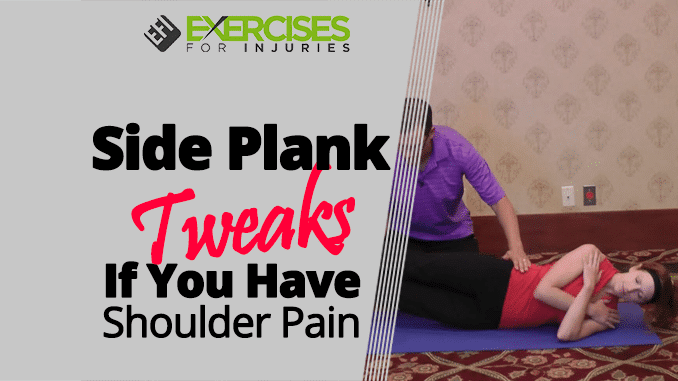In this video, I wanted to go through a modification or a tweak that you can do if you have shoulder pain [1] when doing the side plank. The side plank can place a lot of tension and strain on the shoulder joint, which will not feel good if you are dealing with shoulder pain. Luckily, you can make various adjustments to your side plank to help eliminate shoulder pain.
By now, You’ve probably heard the news: side planks [2] are great for toning your core. But did you know this classic fitness move can also help relieve shoulder pain?
You can use the side plank to realign your shoulders and open up tight chest muscles, which puts a lot of pressure on the shoulder joint.
If you have shoulder pain, it’s coming from your rotator cuff and upper back. This is a common problem for people who spend much time on their computers or phones. Let’s look at two simple side plank tweaks to side planks to help relieve this issue!
You will get all the benefits without putting your back or spine in danger.
Side planks are good for strengthening [3] and toning the core muscles of your abdomen and sides. They help improve posture by strengthening your abdominal muscles and stretching them.
Alex Polish (NASM-CNC, ACE-CPT, SITA-SIFS) explains that side planks can help ease shoulder discomfort when done the right way. They suggest using modifications, like adjusting your position, to take pressure off the shoulder.
Alex also stresses the importance of engaging your core muscles, letting your hips and obliques do most of the work, which can strengthen your shoulder without overworking it.
A side plank alternative for shoulder injury could be a modified side-lying leg lifts or a standing twist and seated side bend exercises, such as the following:
Regular Full-Length Side Plank
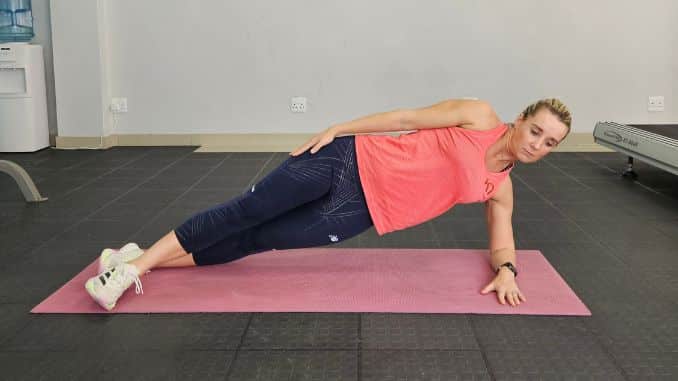
- Lie on one side with your legs extended and stacked on top of each other.
- Place your left elbow directly under your shoulder to align your head, shoulders, and hips properly.
- Plant your forearm firmly on the ground for stable support.
- Bend your left leg at the knee to decrease the load on your shoulder and provide additional stability.
- Then, tighten your core and gently lift your hips off the floor, aiming to create a straight line from your head to your knees.
- Hold this position for several deep belly breaths, in through your nose and out through your mouth.
- Carefully lower your hips back to the starting position.
- Moreover, depending on your comfort level, switch sides and repeat the movement to ensure balanced strength and flexibility on both sides of your body.
Benefits:
- Comprehensive Strength
Works your sides, shoulders, and hips all at once. - Shoulder Conditioning
Builds shoulder strength gently, especially with changes like bent knees. - Postural Benefits
Additionally, helps also keep your back and shoulders straight. - Real-World Application
Prepares you for everyday movements like lifting or stretching.
A regular full-length side plank will help you build a strong core and shoulder muscle. Additionally, it can also improve your posture, relieve back pain and increase your upper body strength.
Regular full-length side plank is one of the most effective exercises for a strong core. It provides many benefits because it strengthens not only your core but also your shoulders.
Moreover, this is a full-side plank, with the forearm on the ground and the elbow underneath the shoulder. Many people find this side plank painful on their shoulders.
Let’s go through some ways to modify the side plank to take the strain off the shoulder.
Modified Side Plank
To avoid discomfort and continue strengthening your core, consider also this effective side plank alternative for shoulder injury modifications:
1. Side Plank (1st Modification)
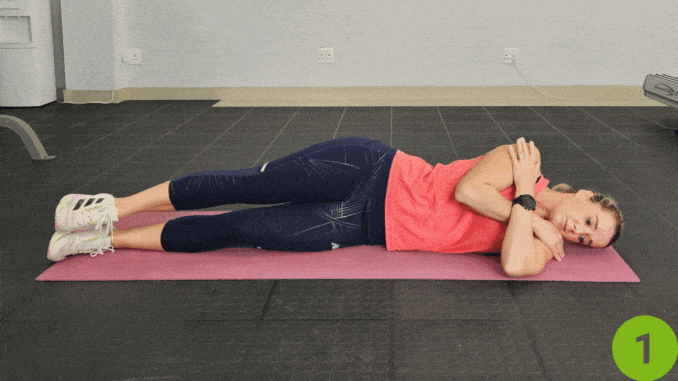
- Lie on your side with your legs extended and stacked on top of each other, aligning your body in a straight line from your head to your feet.
- Then, cross your arms in front of your chest.
- Tighten your abdominal muscles.
- Slowly raise both legs off the ground, keeping them straight. Moreover, gently lower your legs back to the starting position.
2. Side Plank (2nd Modification)
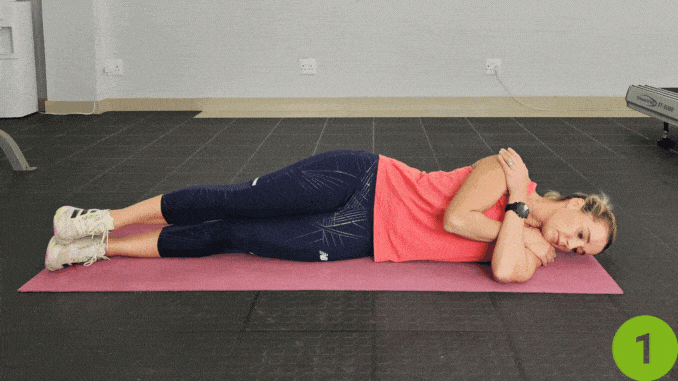
Once you’ve mastered lifting your legs in the first modification, you can add a bit more challenge with this next step.
Start in the same side plank position with your body aligned in a straight line. Now, lift your legs, upper body, and lower back off the ground at the same time, then gently lower them back down. Additionally, as you repeat this movement, make sure to keep your hips and shoulders stacked to maintain proper form.
This progression works both your upper and lower body, helping to build even more strength.
Moreover, if you have lower back issues, you must be cautious about this modification. Since you are doing a side crunch movement, you will put more stress on your lower back. However, you are giving the shoulder a break.
If you have lower back issues, you must be cautious about this modification. Since you are doing a side crunch movement, you will put more stress on your lower back. However, you are giving the shoulder a break.
This modification reduces the strain on your shoulder [4] while still targeting your obliques and core. It’s a great option as a side plank alternative for shoulder injury.
Benefits:
- Core Strength
Helps strengthen your tummy and side muscles without hurting your shoulder. - Spinal Alignment
Keeps your back straight, easing pain in the lower back. - Lower Shoulder Load
Moreover, bending the knee makes it easier on your shoulder, perfect for sore or injured shoulders. - Postural Improvement
Helps you stand or sit better by aligning your upper body.
Exercise Alternatives to Alleviate Shoulder Pain
1. Standing Twist
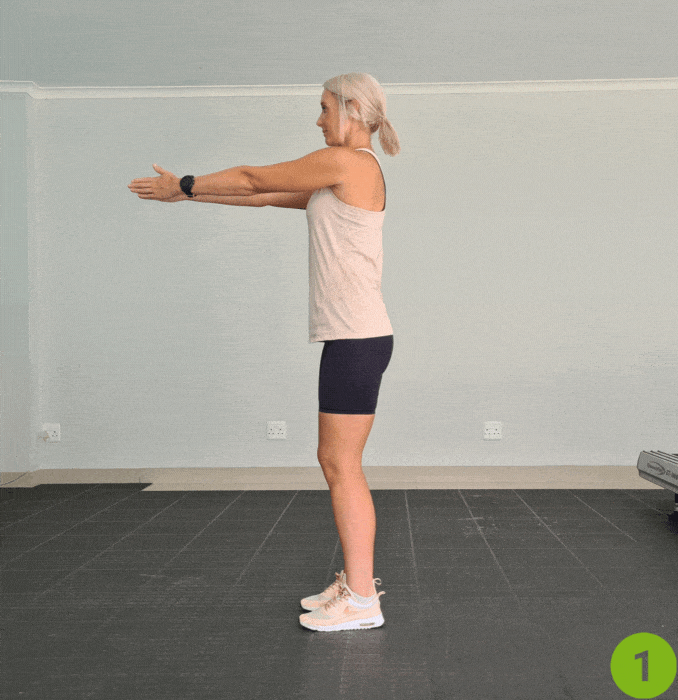
- Begin in an upright standing position with your feet shoulder-width apart, maintaining good alignment with your head, shoulders, hips, and legs.
- Then, extend your arms in front of your body with your palms pressed together at chest height. Engage your core.
- Twist your upper body as you open one arm out to the side, keeping your hips locked in the forward position.
- Moreover, return to the starting position and repeat the movement on the opposite side.
Benefits:
- Looser Shoulders
This move helps make your shoulders less stiff and more flexible, so you can move them further and more easily. - Less Tension
It eases tightness in your shoulders and upper back, making you feel more relaxed and comfortable. - Stronger Core
Moreover, twisting works your side abs (the obliques), keeping your body steady and making your core stronger. - Everyday Movement Made Easier
Twisting and turning—whether to grab something behind you or during sports—becomes smoother and easier. - Healthier Spine
Additionally, it gets your upper spine moving better, which helps improve posture and avoid stiffness from sitting too much. - Stable Hips
Keeping your hips locked forward while you twist helps strengthen your lower body and improves control.
Dr. John R. Schultz, M.D., a national expert and specialist in Interventional Orthopedics, points out that twisting exercises are excellent for improving shoulder flexibility and relieving tension. These exercises target the shoulders and upper back, helping to reduce stiffness and promote better mobility. He emphasizes their role in both easing existing pain and preventing future discomfort by keeping the shoulder area relaxed and strong
2. Side Bends
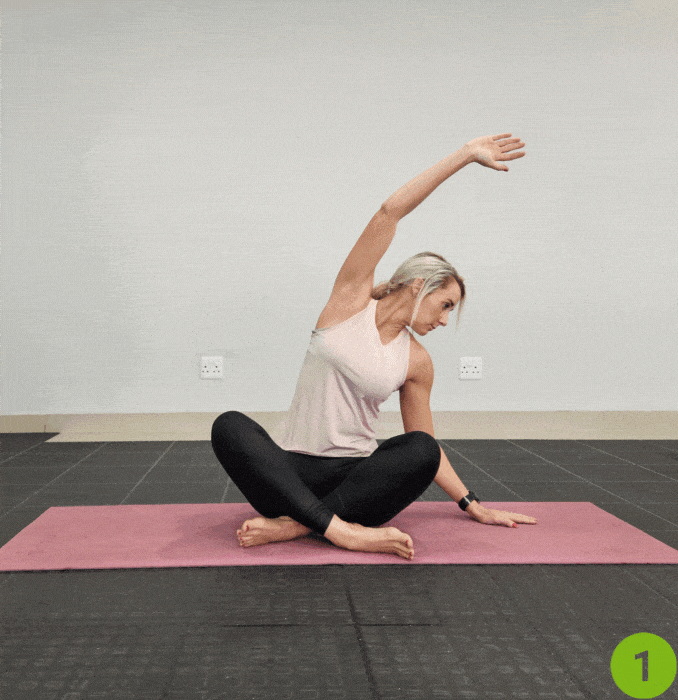
- Begin in an upright sitting position on the floor with your legs crossed.
- Then, maintain good alignment with your head, shoulders, and hips.
- Press one hand on the floor by the outer hip for support.
- Engage your core and inhale as you bend your upper body to the side, reaching over your head with your other arm while keeping your seat firmly flat on the floor.
- Exhale as you repeat the movement on the opposite side.
- Moreover, repeat the movement for 6 repetitions.
Benefits:
- Side Stretching: Stretches your sides, easing tension in the muscles near your ribs.
- Improved Shoulder Mobility: Additionally, makes your shoulders and upper body more flexible, reducing aches.
- Core Activation: Builds strength in the sides of your tummy for better balance.
- Spinal Health: Gently stretches your back, helping with back pain.
3. Bird Dog

- Begin in a 4-point position on the floor, with your hands beneath your shoulders and your knees under your hips. Contract your abdominal area.
- Then, take a deep breath and lift your right arm to be in line with your shoulder as you extend your opposite leg behind your body.
- Keep your right arm, shoulders, hips, and right leg parallel to the floor.
- Lower your arm and leg to return to the starting position.
- Moreover, repeat the movement on the opposite side. Complete 10 repetitions on each side.
Benefits:
- Core Stability
Strengthens tummy and back muscles, improving balance. - Shoulder Support
Additionally, keep your shoulder steady as you reach with your arm. - Back Health
Takes pressure off your lower back by spreading the work. - Coordination
Improves how well your body moves together.
Each side plank alternative for shoulder injury is designed to minimize stress while maintaining effectiveness in building core strength.
Joanna Dennstaedt, a cancer survivor in her 40s, faced a tough recovery after a serious shoulder injury in 2020. Guided by Kelly Clancy, PT, DPT, Joanna rebuilt strength and mobility through targeted exercises like stretching, small movements, strength training, and tools like a TENS machine and arm bicycle. The active lifestyle she loves, which she credits to the exercises and expert support she received.
Precautions and Safety Tips
- Recognizing Pain:
- Stop and reassess if you feel sharp, persistent pain during exercises, particularly in the upper body. Additionally, pain that limits movement should never be ignored.
- Gradual Progression:
- Slowly increase the intensity and duration of your workout to build strength without overloading your lower body or shoulder stability. Moreover, this gradual approach minimizes the risk of injury.
- Maintaining Proper Form:
- Ensure correct alignment of your upper body and engage the appropriate muscles. If you’re unsure, consult a fitness professional to perfect your technique and avoid strain.
Tracking Your Progress and Staying Motivated

Fitness is about more than just exercises—it’s about creating habits that support your body’s recovery and strength. Use these tools to stay on track:
- Recovery Journal:
- Record how long you can maintain a plank position, or how stable you feel while engaging your muscles. Moreover, documenting even small improvements can boost motivation.
- Self-Assessment Checklist:
- Periodically test your ability to lift your left arm overhead or hold a balanced position in exercises targeting your lower body. Additionally, these benchmarks can highlight areas of improvement and guide your progress.
- Celebrate Milestones:
- Acknowledge every achievement, no matter how small—whether it’s more stable shoulders, stronger upper body or better endurance. Moreover, each step is progress toward recovery and long-term strength.
Conclusion
Finding side plank alternatives for shoulder injury has been a total game-changer for me.
I used to think I’d have to give up planks altogether because of the pain, but small tweaks—like bending my knee or trying simpler moves—helped me stay on track.
Honestly, even the tiniest wins felt like a huge deal, and knowing I could keep building my core strength without making my shoulder worse was a relief.
If you’re struggling with shoulder pain, don’t give up! Additionally, it’s all about listening to your body and being okay with making adjustments.
Trust me, it’s worth it.
Start slow, try different modifications, and celebrate every bit of progress along the way. Moreover, i’d love to hear how you’re handling it—what’s your favorite side plank alternative for shoulder injury? Let’s keep moving forward together!
Lastly, if you are looking for a program to help you overcome shoulder pain, click here to check out the Shoulder Pain Solved program.
Frequently Asked Questions (FAQs)
How to do side planks without hurting shoulders?
To avoid shoulder pain during side planks, try these modifications:
- Bend your knees: This reduces the load on your shoulders while still engaging your core.
- Adjust arm positioning: Keep your supporting elbow directly under your shoulder for proper alignment.
- Engage your core: Let your core muscles, hips, and obliques do the heavy lifting, minimizing strain on the shoulder.
- Use props: Support your upper body with a yoga block or similar object for additional stability.
What is a good substitute for side planks?
If side planks are uncomfortable, consider these alternatives:
- Modified Side Plank: Bend your bottom knee while maintaining alignment to reduce shoulder strain.
- Standing Twist: Focus on improving shoulder flexibility and oblique strength.
- Seated Side Bend: A gentle stretch for your sides and shoulders, improving mobility.
- Bird Dog: Strengthens the core and shoulders without weight-bearing stress.
Can I do planks with a shoulder injury?
Yes, with modifications. Opt for exercises that reduce the load on your shoulder, such as:
- Modified side planks with bent knees.
- Non-weight-bearing alternatives like standing twists or seated side bends.
- Always consult a medical professional or physical therapist before exercising with an injury.

